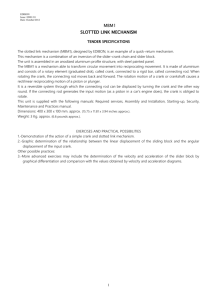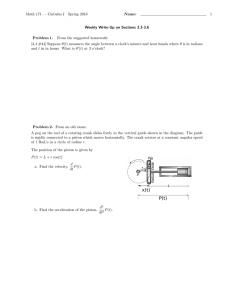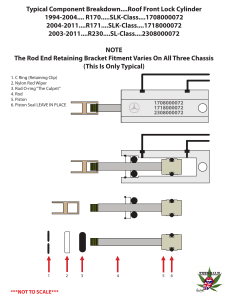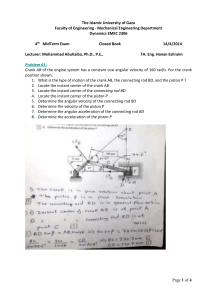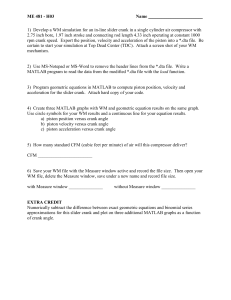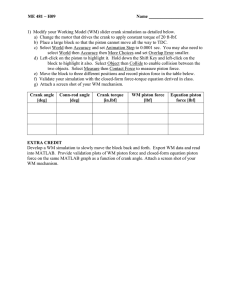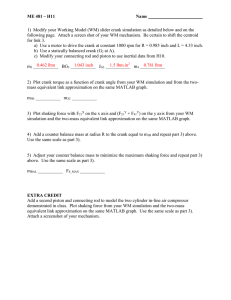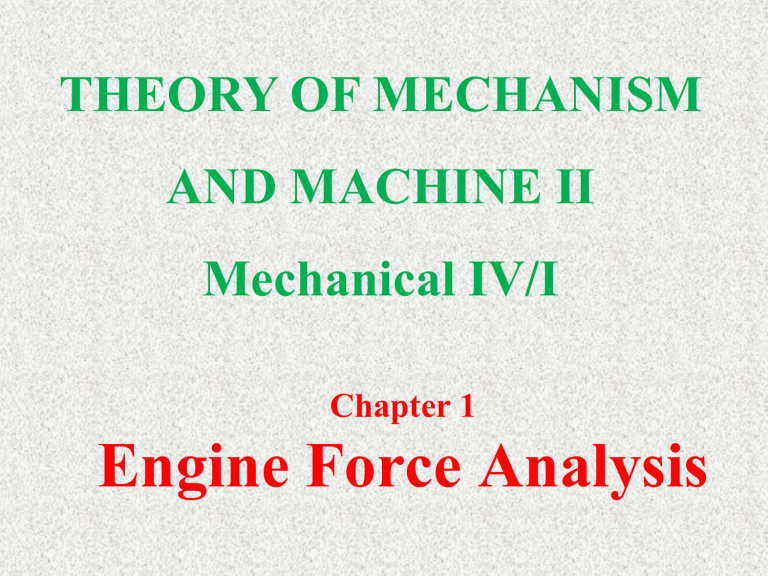
THEORY OF MECHANISM AND MACHINE II Mechanical IV/I Chapter 1 Engine Force Analysis 1.1 Analytical Method for Velocity and Acceleration of the Piston and the Connecting Rod Let OC be the crank and PC the connecting rod. Let the crank rotates with angular velocity of ω rad/s and the crank turns through an angle θ from the inner dead centre. Let x be the displacement of a reciprocating body P from I.D.C. after time t seconds, during which the crank has turned through an angle θ. THEORY OF MECHANISMS AND MACHINES II 2 l= Length of connecting rod between the centers, r= Radius of crank or crank pin circle, = Inclination of connecting rod to the line of stroke PO, and n= Ratio of length of connecting rod to the radius of crank = l/r. THEORY OF MECHANISMS AND MACHINES II 3 Velocity of the piston From the geometry of Figure 1.1, From triangles CPQ and CQO, THEORY OF MECHANISMS AND MACHINES II 4 We know that, Expanding the above expression by binomial theorem and neglecting higher order terms, we get Substituting cos into Equation [1.1], we get Differentiating Equation [1.4] with respect to , we get THEORY OF MECHANISMS AND MACHINES II 5 Velocity of P with respect to O or velocity of the piston P is then given by Acceleration of the piston Since the acceleration is the rate of change of velocity, therefore acceleration of the piston P, Differentiating Equation [1.7] with respect to , we get THEORY OF MECHANISMS AND MACHINES II 6 Angular Velocity and Acceleration of the Connecting Rod From Equation 1.2, Differentiating both sides with respect to time t, THEORY OF MECHANISMS AND MACHINES II 7 Since the angular velocity of the connecting rod PC is same as the angular velocity of point P with respect to C and is equal to d/dt, therefore angular velocity of the connecting rod We know that, Angular acceleration of the connecting rod PC is then given by THEORY OF MECHANISMS AND MACHINES II 8 Now differentiating Equation [1.13], we get Substituting dPC/d, from Equation [1.15] into Equation [1.14], we get THEORY OF MECHANISMS AND MACHINES II 9 Example 1.1 The stroke of a steam engine is 600 mm and the length of connecting rod is 1.5 m. The crank rotates at 180 r.p.m. Determine: a) velocity and acceleration of the piston when crank has travelled through an angle of 40° from inner dead centre, and b) the position of the crank for zero acceleration of the piston. 4.1918 m/s, 85.356 m/s2, 79.270 THEORY OF MECHANISMS AND MACHINES II 10 1.2 Forces on the Reciprocating Parts of an Engine THEORY OF MECHANISMS AND MACHINES II 11 Piston effort It is the net force acting on the piston or crosshead pin, along the line of stroke. It is denoted by FP. We know that acceleration of the reciprocating parts Accelerating force or inertia force of the reciprocating parts THEORY OF MECHANISMS AND MACHINES II 12 It may be noted that in a horizontal engine, the reciprocating parts are accelerated from rest, when the piston moves from inner dead centre to outer dead centre. It is, then, retarded when the piston moves from outer dead centre to inner dead centre. The inertia force due to the acceleration of the reciprocating parts, opposes the force on the piston due to the difference of pressures in the cylinder on the two sides of the piston. On the other hand, the inertia force due to retardation of the reciprocating parts, helps the force on the piston. THEORY OF MECHANISMS AND MACHINES II 13 The – ve sign is used when the piston is accelerated, and + ve sign is used when the piston is retarded. In a double acting reciprocating steam engine, net load on the piston, THEORY OF MECHANISMS AND MACHINES II 14 If ‘p’ is the net pressure of steam or gas on the piston and D is diameter of the piston, then net load on the piston, In case of a vertical engine, the weight of the reciprocating parts assists the piston effort during the downward stroke (i.e. when the piston moves from top dead centre to bottom dead centre) and opposes during the upward stroke of the piston (i.e. when the piston moves from bottom dead centre to top dead centre). Force acting along the connecting rod It is denoted by FQ. THEORY OF MECHANISMS AND MACHINES II 15 Thrust on the sides of the cylinder walls or normal reaction on the guide bars It is denoted by FN. Crank-pin effort and thrust on crank shaft bearings The force acting on the connecting rod FQ may be resolved into two components, one perpendicular to the crank and the other along the crank. The component of FQ perpendicular to the crank is known as crank-pin effort and it is denoted by FT. The component of FQ along the crank produces a thrust on the crank shaft bearings and it is denoted by FB. THEORY OF MECHANISMS AND MACHINES II 16 Crank effort or turning moment or torque on the crank shaft The product of the crankpin effort (FT) and the crank pin radius (r) is known as crank effort or turning moment or torque on the crank shaft THEORY OF MECHANISMS AND MACHINES II 17 As we know THEORY OF MECHANISMS AND MACHINES II 18 Example 1.2 A petrol engine 90 mm in diameter and 120 mm stroke has a connecting rod of 240 mm length. The piston has a mass of 1 kg and the speed is 1800 rpm. On the explosion stroke with the crank at 30° from top dead centre, the gas pressure is 0.5 N/mm2. Determine: a)the resultant load on the gudgeon pin, b)the thrust on the cylinder walls c)the crank effort at the given position of the crank, and d) the speed, above which other things remaining same, the gudgeon pin load would be reversed in direction. THEORY OF MECHANISMS AND MACHINES II 19 1.3 Equivalent Dynamical System In order to determine the motion of a rigid body, under the action of external forces, it is usually convenient to replace the rigid body by two masses placed at a fixed distance apart, in such a way that, • the sum of their masses is equal to the total mass of the body; • the centre of gravity of the two masses coincides with that of the body ; and • the sum of mass moment of inertia of the masses about their centre of gravity is equal to the mass moment of inertia of the body. When these three conditions are satisfied, then it is said to be an equivalent dynamical system. THEORY OF MECHANISMS AND MACHINES II 20 Consider a rigid body, having its centre of gravity at G, as shown in Figure. THEORY OF MECHANISMS AND MACHINES II 21 Thus, for the two masses to be dynamically equivalent, From Equations [1.28] and [1.29], THEORY OF MECHANISMS AND MACHINES II 22 This equation gives the essential condition of placing the two masses, so that the system becomes dynamical equivalent. The distance of one of the masses (i.e. either l1 or l2) is arbitrary chosen and the other distance is obtained from Equation [1.33]. When the radius of gyration kG is not known, then the position of the second mass may be obtained by considering the body as a compound pendulum. As we know that the length of the simple pendulum which gives the same frequency as the rigid body (i.e. compound pendulum) is THEORY OF MECHANISMS AND MACHINES II 23 Replacing h by l1, This means that the second mass is situated at the centre of oscillation or percussion of the body, which is at a distance of THEORY OF MECHANISMS AND MACHINES II 24 1.4 Analytical Method for Inertia Torque (Considering Weight of the Connecting Rod) The effect of the inertia of the connecting rod on the crankshaft torque may be obtained by using equivalent dynamic system. The mass of the connecting rod (mC) is divided into two masses. One of the mass is placed at the crosshead pin P and the other at the crankpin C as shown in Figure, so that the centre of gravity of these two masses coincides with the centre of gravity of the rod G. THEORY OF MECHANISMS AND MACHINES II 25 Mass of the connecting rod at P The mass of the reciprocating parts (mR) is also acting at P. Therefore, total equivalent mass of the reciprocating parts acting at P Total inertia force of the equivalent mass acting at P, THEORY OF MECHANISMS AND MACHINES II 26 Then, the corresponding torque exerted on the crank shaft, THEORY OF MECHANISMS AND MACHINES II 27
